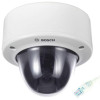Bosch NWD-495V03-20P Operating Instructions - Page 19
Tri Streaming, Recording, Multicast, Encryption, Configuration, Tampering recognition and motion - firmware
 |
View all Bosch NWD-495V03-20P manuals
Add to My Manuals
Save this manual to your list of manuals |
Page 19 highlights
FlexiDomeDN IP Introduction | en 19 1.4.6 1.4.7 1.4.8 1.4.9 1.4.10 1.4.11 Tri Streaming Tri Streaming allows the incoming data stream to be encoded simultaneously according to three different, individually customized profiles. This creates two MPEG4 streams per camera that can serve different purposes, for example, one for local recording and one optimized for transmission over the LAN, and an additional JPEG stream for use with a PDA. Recording The camera can be used with an iSCSI server connected via the network to store long-term recordings. Multicast In suitably configured networks, the multicast function enables simultaneous, real time transmission to multiple receivers. The prerequisite for this is that the UDP and IGMP V2 protocols are implemented on the network. Encryption The data transmissions and the authentication channel can be encrypted to prevent unauthorized access. Web browser connections can be protected using HTTPS. Configuration The camera can be configured using a browser on the local network (Intranet) or from the Internet. Similarly, firmware updates and rapid loading of device configurations are also possible. Configuration settings can be stored as files on a computer and copied from one camera to another. Tampering recognition and motion detectors The camera offers a wide range of configuration options for alarm signaling in the event of tampering with the camera. An algorithm for detecting movement in the video image is also part of the scope of delivery and can optionally be extended to include special video analysis algorithms. Bosch Security Systems Operating Instructions V 1.0 | 2006.12















